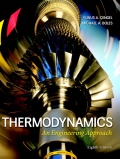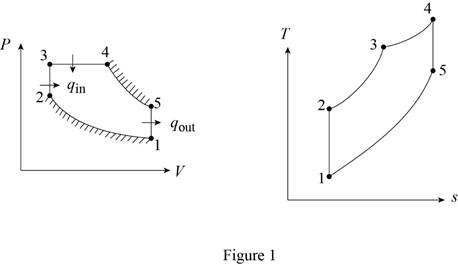
An air-standard cycle, called the dual cycle, with constant specific heats is executed in a closed piston– cylinder system and is composed of the following five processes:
1-2 Isentropic compression with a compression ratio, r = V1/V2
2-3 Constant-volume heat addition with a pressure ratio, rp = P3/P2
3-4 Constant-pressure heat addition with a volume ratio, rc V4/V3
4-5 Isentropic expansion while work is done until V5 = V1
5-1 Constant-volume heat rejection to the initial state
- (a) Sketch the P-ν and T-s diagrams for this cycle.
- (b) Obtain an expression for the cycle thermal efficiency as a function of k, r, rc, and rp.
- (c) Evaluate the limit of the efficiency as rp approaches unity, and compare your answer with the expression for the Diesel cycle efficiency.
- (d) Evaluate the limit of the efficiency as rc approaches unity, and compare your answer with the expression for the Otto cycle efficiency.
(a)
Draw the
Answer to Problem 64P
The
Explanation of Solution
Draw the

Thus, the
(b)
The expression for the back work ratio as a function of k and r.
Answer to Problem 64P
The expression for the back work ratio as a function of
Explanation of Solution
Apply first law to the closed system for processes 2-3, 3-4, and 5-1 to get the expression of
Here, heat added to the system and heat rejected from the system is
Express the cycle thermal efficiency.
Conclusion:
Process 1-2: Isentropic
Calculate the ratio of
Here, volume at states 1 and 2 is
Process 2-3: Constant volume
Calculate the expression for
Here, pressure at state 1 and 2 is
Process 3-4: Constant pressure
Calculate the expression for
Here, compression ratio is
Process 4-5: Isentropic
Calculate the expression for
Process 5-1: Constant volume
Calculate the expression for
Substitute
Calculate the ratio of
Substitute
Substitute
Substitute
Thus, the expression for the back work ratio as a function of
(c)
The limit of the efficiency as
Answer to Problem 64P
The limit of the efficiency as
Explanation of Solution
Recall the expression for the back work ratio as a function of
Thus, the limit of the efficiency as
The limit of the efficiency as
(d)
The limit of the efficiency as
Answer to Problem 64P
The limit of the efficiency as
Explanation of Solution
Recall the expression for the back work ratio as a function of
Thus, the limit of the efficiency as
The limit of the efficiency as
Want to see more full solutions like this?
Chapter 9 Solutions
EBK THERMODYNAMICS: AN ENGINEERING APPR
- Two forces are applied as shown to a hook support. The magnitude of P is 38 N. 50 N 25° DG a 터 Using trigonometry, determine the required angle a such that the resultant R of the two forces applied to the support will be horizontal. The value of a isarrow_forwardNo chatgpt pls will upvotearrow_forward101 the three shafts if the diameter ratio is 2 (D/d = 2)? Ans. na, tension = 1.21, na, bending = 1.19, na, torsion = 1.17. 6.32 A material with a yield strength of S₁ = 350 MPa is subjected to the stress state shown in Sketch c. What is the factor of safety based on the maximum shear stress and distortion energy theories? Ans. For MSST, n, = 11.67. 50 MPa 85 MPa 20 MPa 70 MPa Sketch c, for Problems 6.32 and 6.33arrow_forward
- Can you draw the left view of the first orthographic projectionarrow_forwardImportant: I've posted this question twice and received incorrect answers. I've clearly stated that I don't require AI-generated working out. I need a genuine, expert-written solution with proper working. If you can't provide that, refer this question to someone who can please!. Note: Please provide a clear, step-by-step handwritten solution (no AI involvement). I require an expert-level answer and will assess it based on quality and accuracy with that I'll give it a thumbs up or down!. Hence, refer to the provided image for clarity. Double-check everything for correctness before submitting. Thank you!arrow_forwardNote: Please provide a clear, step-by-step simplified handwritten working out (no explanations!), ensuring it is done without any AI involvement. I require an expert-level answer, and I will assess and rate based on the quality and accuracy of your work and refer to the provided image for more clarity. Make sure to double-check everything for correctness before submitting appreciate your time and effort!. Question:arrow_forward
- Note: Please provide a clear, step-by-step simplified handwritten working out (no explanations!), ensuring it is done without any AI involvement. I require an expert-level answer, and I will assess and rate based on the quality and accuracy of your work and refer to the provided image for more clarity. Make sure to double-check everything for correctness before submitting appreciate your time and effort!. Question: If the flow rate through the system below is 0.04m3s-1, find the difference in elevation H of the two reservoirs.arrow_forwardNote: Please provide a clear, step-by-step simplified handwritten working out (no explanations!), ensuring it is done without any AI involvement. I require an expert-level answer, and I will assess and rate based on the quality and accuracy of your work and refer to the provided image for more clarity. Make sure to double-check everything for correctness before submitting thanks!. Question: (In the image as provided)arrow_forwardNote: Please provide a clear, step-by-step simplified handwritten working out (no explanations!), ensuring it is done without any AI involvement. I require an expert-level answer, and I will assess and rate based on the quality and accuracy of your work and refer to the provided image for more clarity. Make sure to double-check everything for correctness before submitting thanks!. Question: The rectangular gate shown below is 3 m wide. Compute the force P needed to hold the gate in the position shown.arrow_forward
 Elements Of ElectromagneticsMechanical EngineeringISBN:9780190698614Author:Sadiku, Matthew N. O.Publisher:Oxford University Press
Elements Of ElectromagneticsMechanical EngineeringISBN:9780190698614Author:Sadiku, Matthew N. O.Publisher:Oxford University Press Mechanics of Materials (10th Edition)Mechanical EngineeringISBN:9780134319650Author:Russell C. HibbelerPublisher:PEARSON
Mechanics of Materials (10th Edition)Mechanical EngineeringISBN:9780134319650Author:Russell C. HibbelerPublisher:PEARSON Thermodynamics: An Engineering ApproachMechanical EngineeringISBN:9781259822674Author:Yunus A. Cengel Dr., Michael A. BolesPublisher:McGraw-Hill Education
Thermodynamics: An Engineering ApproachMechanical EngineeringISBN:9781259822674Author:Yunus A. Cengel Dr., Michael A. BolesPublisher:McGraw-Hill Education Control Systems EngineeringMechanical EngineeringISBN:9781118170519Author:Norman S. NisePublisher:WILEY
Control Systems EngineeringMechanical EngineeringISBN:9781118170519Author:Norman S. NisePublisher:WILEY Mechanics of Materials (MindTap Course List)Mechanical EngineeringISBN:9781337093347Author:Barry J. Goodno, James M. GerePublisher:Cengage Learning
Mechanics of Materials (MindTap Course List)Mechanical EngineeringISBN:9781337093347Author:Barry J. Goodno, James M. GerePublisher:Cengage Learning Engineering Mechanics: StaticsMechanical EngineeringISBN:9781118807330Author:James L. Meriam, L. G. Kraige, J. N. BoltonPublisher:WILEY
Engineering Mechanics: StaticsMechanical EngineeringISBN:9781118807330Author:James L. Meriam, L. G. Kraige, J. N. BoltonPublisher:WILEY





